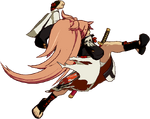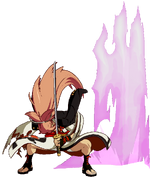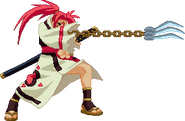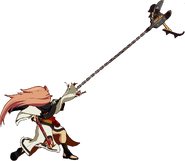Kabari, originally known as Kamaitachi (鎌鼬, Kamaitachi?, lit. Sickle Weasel), is one of Baiken's Special Attacks, first appearing in the original Guilty Gear and would later return in Guilty Gear XX.
Overview[]
Baiken throws out a claw on a chain towards her opponent, pulling them closer to her and stunning them.
In Guilty Gear Xrd Rev 2 (and the Samurai Shodown 2019 reboot), Baiken gains an ![]() version aimed diagonally-upwards, which acts as an anti-air. Additionally, both versions gain followups:
version aimed diagonally-upwards, which acts as an anti-air. Additionally, both versions gain followups:
| Attack | Input | Description |
|---|---|---|
 Himawari (閑割, Himawari?, lit. Leisure Split) |
Baiken rushes forward to grab her opponent, jump high, then slam them on the ground, causing a floor bounce; in Samurai Shodown, it simply causes a hard knockdown. | |
 Tetsuzansen (鉄斬扇, Tetsuzan Sen?, lit. Iron Slash Fan) |
Back in the XX subseries, Baiken drew out her sword in reverse grip for an upwards slash followed-into an backfacing upwards face-away swat to finish.
In Xrd Rev2, Baiken instead draws her blade to flick out a towering geyser of energy. Both versions launch the foe on hit. | |
 Rokkonsogi (六根削ぎ, Rokkon Sogi?, lit. Six Root Paring) |
Baiken slashes her opponent while traveling through them. |

In Guilty Gear -Strive-, the ![]() version is changed from an anti-air to having Baiken tether her opponent with a rope attached to a bell, keeping them from going further than a quarter of a screen for 3 seconds. The
version is changed from an anti-air to having Baiken tether her opponent with a rope attached to a bell, keeping them from going further than a quarter of a screen for 3 seconds. The ![]() version also gains a follow up by holding the button, where Baiken rushes forward and slashes her opponent.
version also gains a follow up by holding the button, where Baiken rushes forward and slashes her opponent.
Details[]
To be added...





